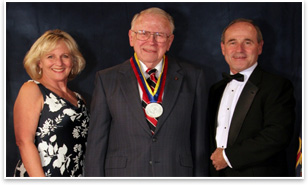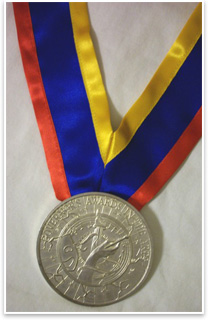
Third Generation Boise Architect Receives Lifetime Achievement Award
Summary: Idaho Gov. James E. Risch honored Boise architect Charles Hummel, FAIA, with the Governor’s Awards in the Arts 2006 Lifetime Achievement Award on October 7. “Chuck is really deserving of a lifetime award,” said Gov. Risch. “His roots run very deep here in Boise. He has spent a lifetime on a number of projects that really changed the face of Boise.” The ceremony took place in the city’s historic Egyptian Theatre, designed by Hummel’s father and completed when Charles was one year old. Charles Hummel led the theater’s renovation three decades ago.
Charles Hummel’s contributions to the Hummel legacy include the U.S. Courthouse and James A. McClure Federal Building; Our Lady of the Valley Church in Caldwell, Idaho; and the Student Union Building and Library at Boise State University. “Architecture is like clothing. It’s our third skin,” says Hummel. “Public buildings reflect something about us. If they’re in a city or town, they have to be part of the urban fabric. They can’t work against it. They have to be in the context of their place. Our work has always respected that.” An Idaho treasure “Out west, we’re a lot different than you are back east,” said Gov. Risch. “We’ve only been a state since 1890, so we don’t have [historic structures] that are hundreds of years old, but we do have monuments that are going to be around for a long time like the [Idaho State] Capitol and St. John’s Cathedral. We don’t have that many monuments, but I have to tell you that virtually every monument we have, either he or his family have fingerprints on from either an original architectural design or a restoration project. I can’t stress enough how influential he and his family have been in defining our monuments.”
Active architecture advocate Hummel also is heavily involved in the local community and has served on boards supporting the arts, including the Boise Art Museum and the Boise Philharmonic. “Art and architecture are twins,” he says. “There’s a unity to all the arts: dance, art and architecture, saddle making, even cooking. I don’t draw a distinction between the so-called higher and the practical arts. They’re all pushed by the same impulse: the need to work and to make the thing right.”
|
||
Copyright 2006 The American Institute of Architects. All rights reserved. Home Page |
||
news headlines
practice
business
design
recent related
› Livable Communities: A Multidisciplinary Dialogue on Designing a Sustainable Future
› Guemes Island Reaches Far for AIA Sustainable Design
› Participants in the One Percent Solution Project Share Their Approaches to Pro Bono Work
The biennial Governor’s Awards in the Arts were established in 1970 by the Idaho Commission on the Arts to elevate recognition and awareness of Idaho arts and artists. The finalists are chosen by an independent, out-of-state panel, with the governor making final selection of the recipients. Twelve awards were given in the categories of Excellence in the Arts, Support of the Arts, Support of Arts Education, Excellence in Arts Administration, and Lifetime Achievement. This is the first time the Governor’s Awards in the Arts has honored an architect with a Lifetime Achievement award.
Caption:
Charles Hummel with his award flanked by Governor Risch and Vicki Risch.

 A third-generation architect, Hummel is the fourth in his family to make architecture his profession. His father, Fritz, and his uncle Frank took over what is now Hummel Architects from Charles’ grandfather, Charles F. Hummel. Founded in 1896, the Hummel firm has had a central role in defining the urban character of Boise. His predecessors were responsible for the Idaho State Capitol, St. John’s Cathedral, and many other historic buildings in the state.
A third-generation architect, Hummel is the fourth in his family to make architecture his profession. His father, Fritz, and his uncle Frank took over what is now Hummel Architects from Charles’ grandfather, Charles F. Hummel. Founded in 1896, the Hummel firm has had a central role in defining the urban character of Boise. His predecessors were responsible for the Idaho State Capitol, St. John’s Cathedral, and many other historic buildings in the state. Although Hummel hails from a family of architects, his career in architecture wasn’t laid out before him. “I knew an awful lot about architecture as a kid,” he says, but “it wasn’t until after the end of World War II that I really made up my mind that I was going to study architecture. My father never told me that I ought to be an architect. I didn’t feel any pressure from my family. I had an uncle who was also a partner in the firm and they had another partner so it wasn’t like automatic succession or anything. I didn’t become a partner in the firm for 10 years after I went to work there, so it wasn’t a drop kick.”
Although Hummel hails from a family of architects, his career in architecture wasn’t laid out before him. “I knew an awful lot about architecture as a kid,” he says, but “it wasn’t until after the end of World War II that I really made up my mind that I was going to study architecture. My father never told me that I ought to be an architect. I didn’t feel any pressure from my family. I had an uncle who was also a partner in the firm and they had another partner so it wasn’t like automatic succession or anything. I didn’t become a partner in the firm for 10 years after I went to work there, so it wasn’t a drop kick.”